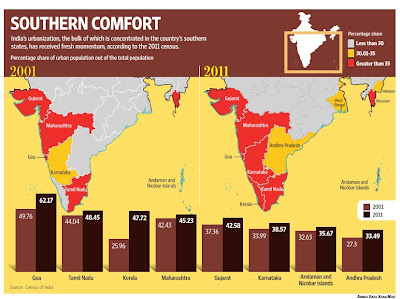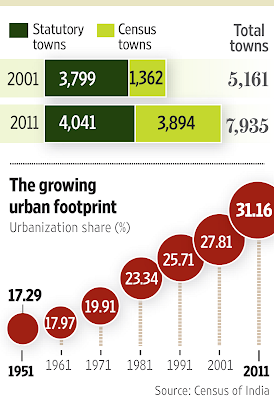It also found that 31.2% of the total population lives in urban centres compared with 27.8% in 2001 and 25.5% in 1991, with South Indian states leading the urban charge. Cumulatively, of the 1.21 billion population, 833 million live in rural India while the remaining 377 million reside in urban India.

The number of towns in the country rose 53.74% to 7,935 between the last two census. However, this conceals an interesting division - the number of statutory towns (notified as a municipality or corporation) rose by 242 to 4,041, while census towns (officially gram panchayats, but have large populations) almost trebled to 3,894. The emergence of such small and informal census towns, especially in states like Kerala (where urban population share nearly doubled in the last decade), is a cause for concern.

As Mint reports, the residents of these census towns benefit from all government benefits that go to rural areas and also lower property taxes and other permit fees. The tax revenues foregone aside, more worryingly, these areas are currently being administered (or not administered) by gram panchayats with limited expertise in managing governance and infrastructure service delivery for larger population centers. This administrative deficit is likely to have adverse long-term consequences for these cities, especially since they are experiencing rapid pace of expansion and development.
These census towns, which are in the early stages of their development, do not have the infrastructure nor the governance capabilities to absorb the sudden influx of migrants from neighbouring villages. Adhoc and chaotic growth in residential settlements and commercial establishments and deficient or absent civic infrastructure are inevitable. The unplanned layouts which emerge from such growth resemble squatter settlements, and leave little scope for future growth and severely constrains the subsequent establishment of standard civic infrastructure facilities.
This failure to plan urban development is a classic case of policy paralysis that characterizes much of policy making in India. In most of these cases, political considerations take precedence over objective requirements. The local panchayats in most cases oppose merger into the neighbouring city or notification as a municipality. Panchayat members risk losing power and play up local resident's fears over higher taxes. Finally, when the merger or notification comes, it is too late. The city's broad topographical layout is already in place, leaving little room for any planned expansion.
On the positive side, in a reflection of the growing political prominence of cities, the number of urban Lok Sabha seats increased from around 70 to at least 100. This growing political influence of urban India will help correct the skewed nature of governance bandwidth in the country. However, since nearly 70% of Indians continue to live in rural areas, the compulsions of electoral politics dictates that rural issues will get priority over urban ones.
No comments:
Post a Comment